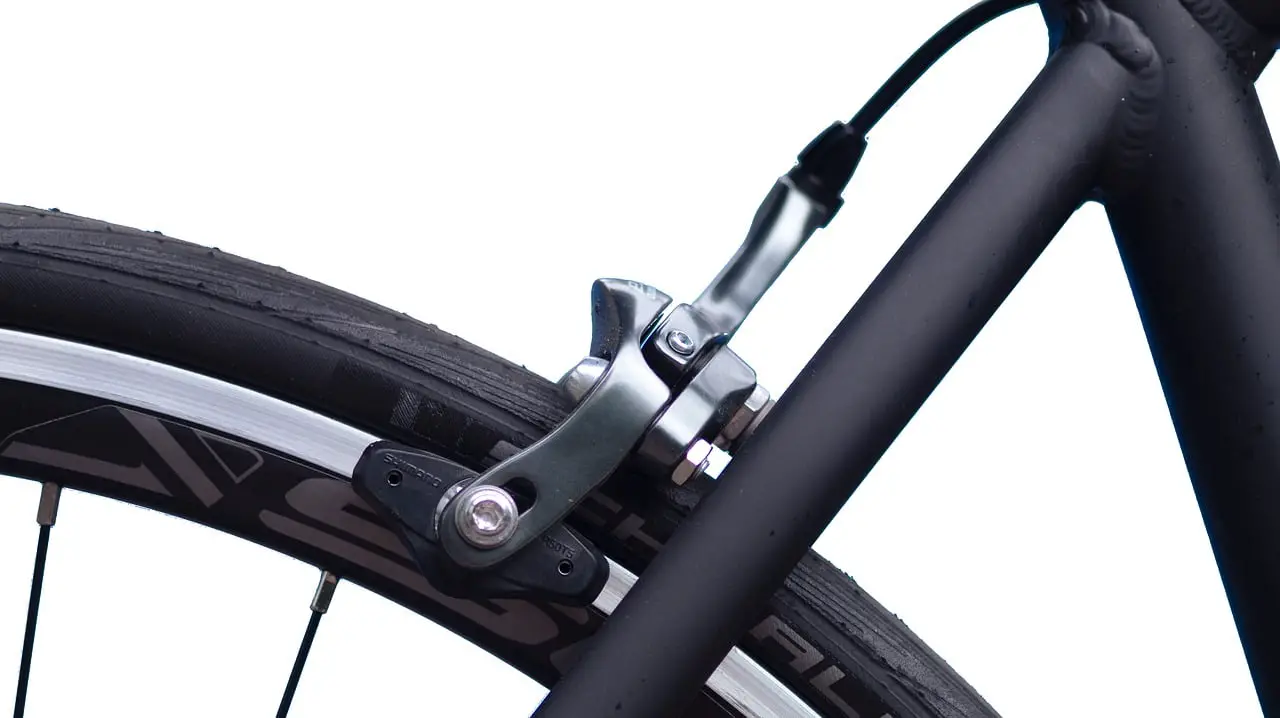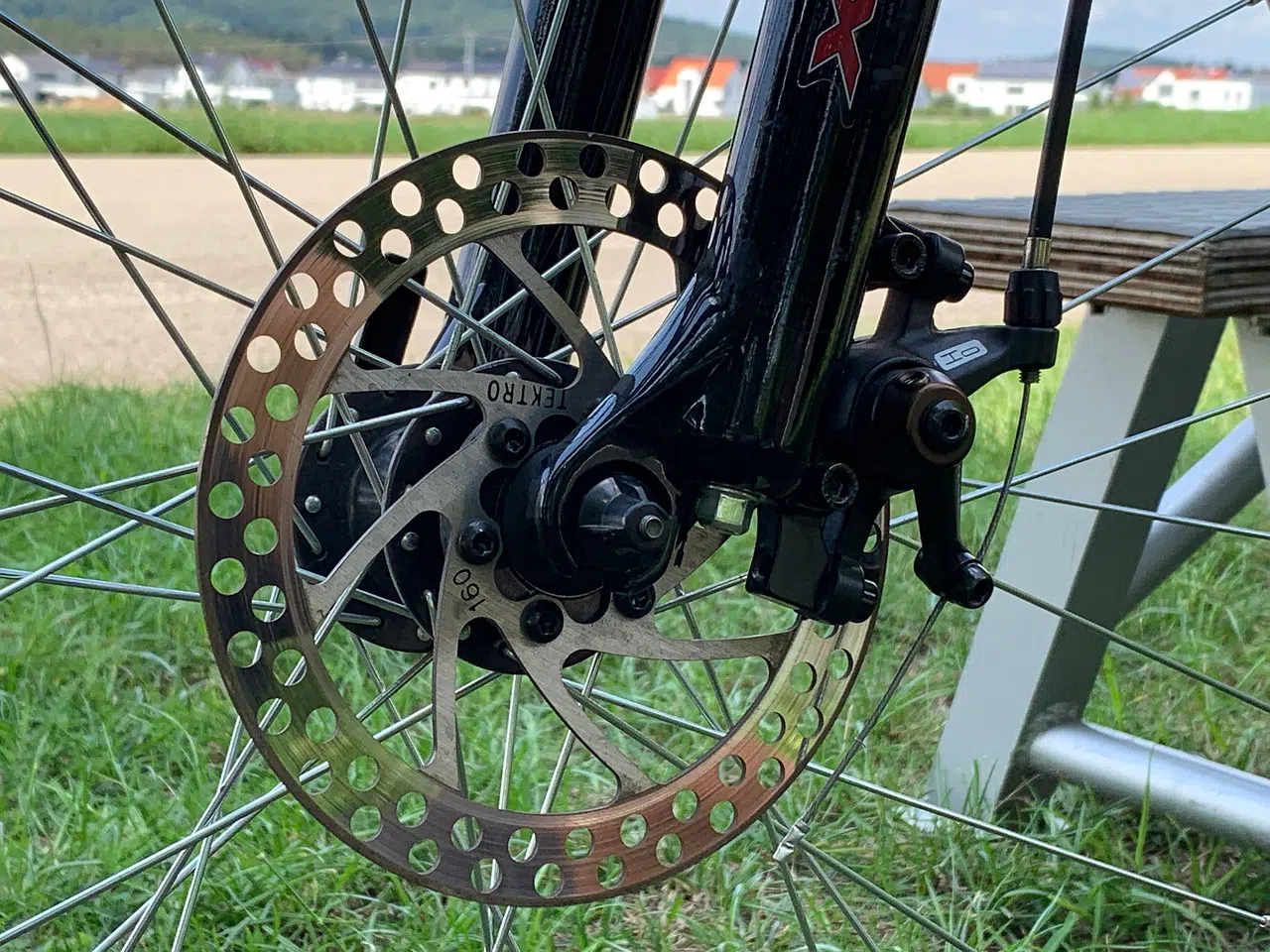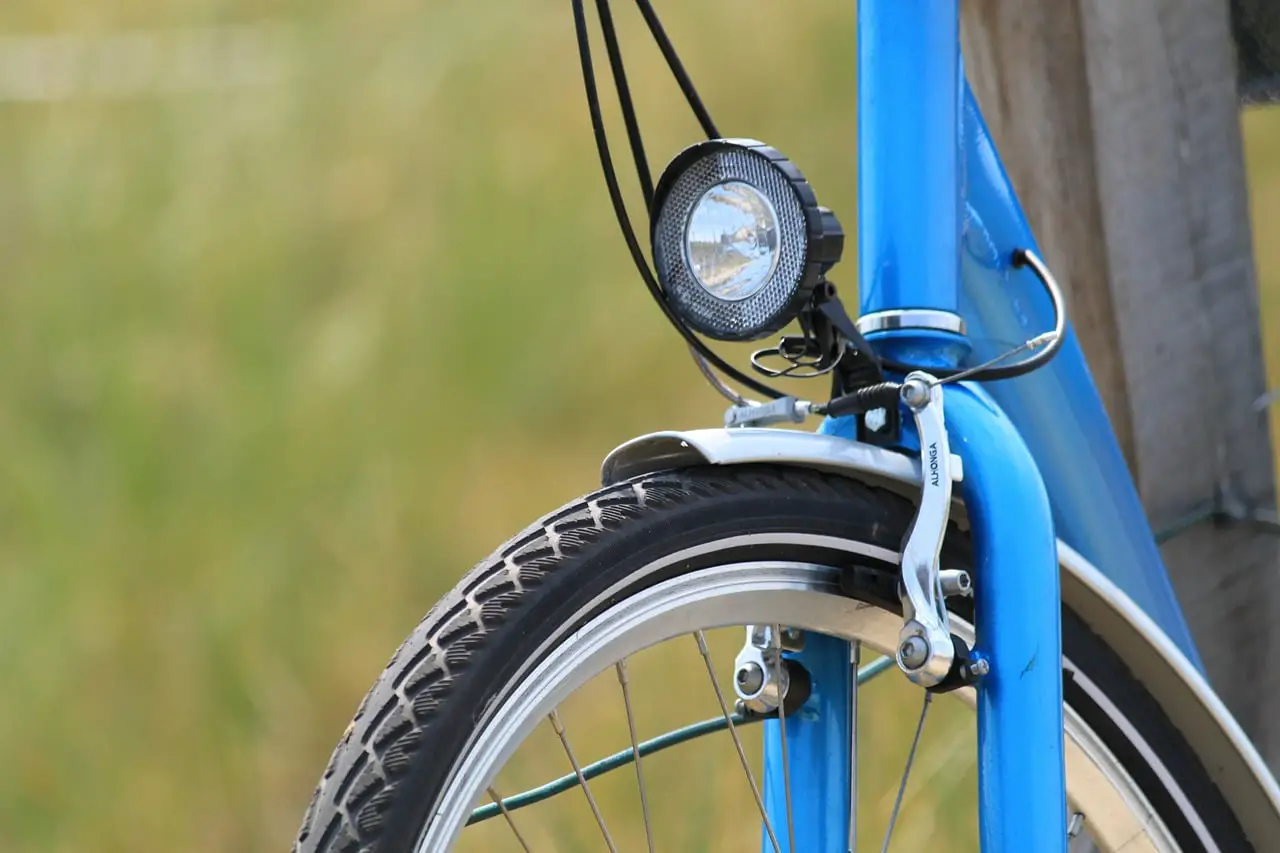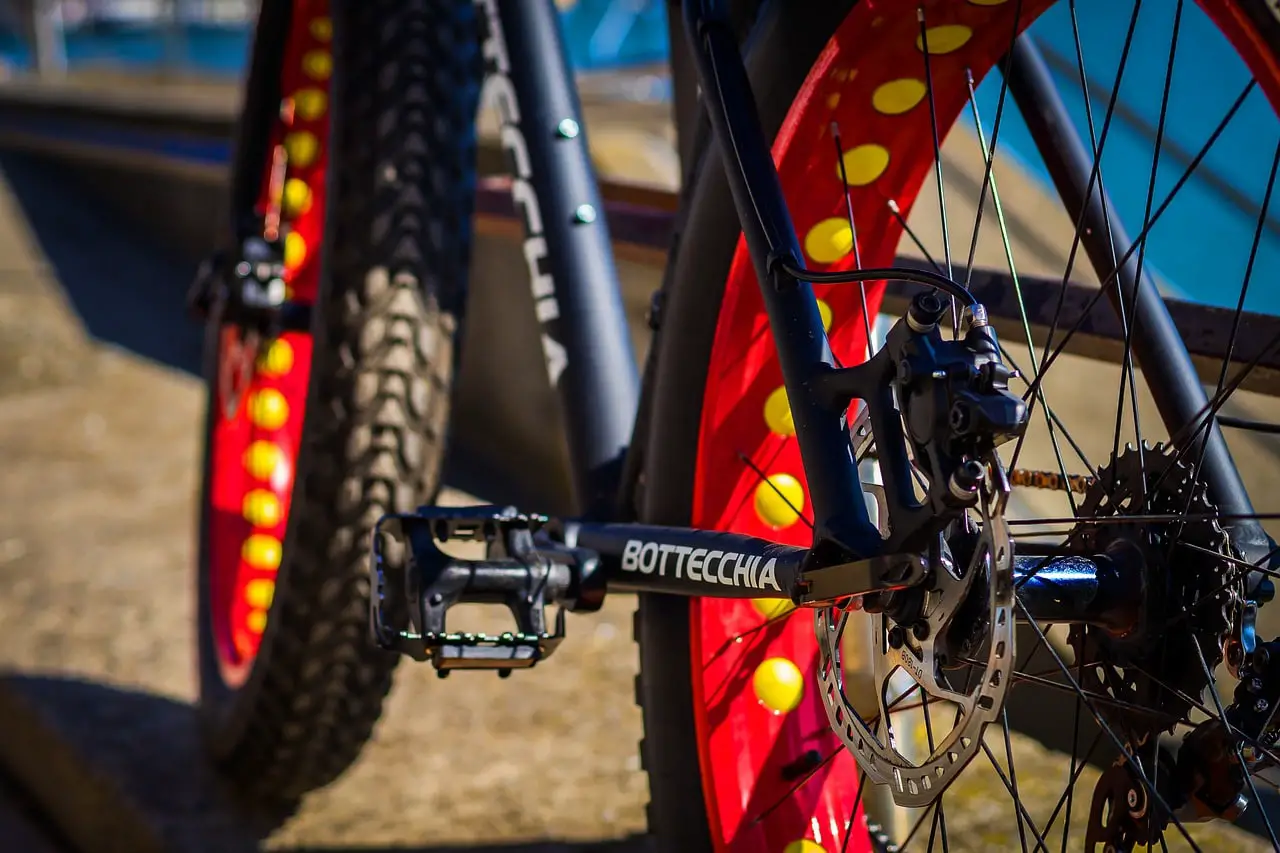How To Center Bike Brakes?
Hi friend, welcome back to BTYCC. Today, I will show you how to center bike brakes to perfectly center on both sides of the wheel rim. It is a very important step in maintaining good braking performance. If you don't do this properly, it can cause uneven wear or even damage the rims. It also affects the ability of the brake pad to grab onto the tire when applying pressure. So let's get started!
How Many Types Of Bike Brakes?
Before we go into the details, we need to know what kind of brakes you have first. There are two types of braking systems: disc brakes and rim brakes. Disc brakes are more common than rim brakes because they offer better stopping power and control.
Rim Brakes

If you ride an old-fashioned steel frame bicycle, you probably already own some rim brakes. Rim brakes consist of pads attached to the wheel's spokes using metal rings called calipers. The front brake is usually located at one end of the handlebars, while the rear brake is mounted near the other end. You may also find them in pairs; these are known as duals.
Disc Brakes

A disc brake consists of discs made from carbon fiber placed between the wheels' hub and axle. They act like friction plates when pressed against each other. Disc brake makes them very powerful but also quite heavy. Because of their weight, disc brakes require special attention during installation and adjustment.
What Is The Difference Between Rim And Disc Brakes?
Rim brake systems are used on most bicycles, including road bikes. They consist of a rim that is attached to the wheel hub by spokes or other means. A caliper with two pads sits in between the rim and disc. When pressure is applied to the lever arm, it pushes against the pad, which presses against the inside surface of the edge, creating friction. The Rim brake creates resistance when turning the pedals.
The advantage of rim brakes over disk brakes is that no additional weight is added to the system. Also, since the brake rotates along with the wheel, it does not affect steering. On the downside, however, rim brakes have less stopping power compared to disc brakes.
Disk brakes have initially been designed for mountain biking, where you often need speed. These brakes provide greater stopping force than rim brakes. But due to their size and weight, they cannot be installed on road bikes without modification. In addition, they must be carefully adjusted so that they won't interfere with handling.
Why Should We Center Our Bike Brake Pads?
When adjusting your brakes, it is essential to keep everything centered around the axis of rotation. Otherwise, the brake pads could rub against the sidewall of the rim, causing uneven wear. Or worse yet, the brake pads might touch the rim itself, damaging the material. Roughly 70% of your bike's braking power happens at the front wheel, so make sure you have a well-suited tread.
To avoid such problems, we recommend centering your brake pads about 1/8" away from the tire's sidewall. This distance can vary depending on how much clearance there is between the tire and the rim. If you don't have enough room, try moving the brake closer to the rim until you get the desired effect.
How To Center Your Bicycle Rim Brakes?

Rim brakes work differently than disc brakes because they use a different type of technology. Instead of having disks sandwiched between the wheel and axles, rims have holes drilled around the wheel's circumference where the brake pads attach. These holes allow air to flow freely under high-speed conditions, making them less effective. However, they're much lighter than disk brakes and therefore easier to install.
There are several ways to align your rim brakes properly. Here are three methods:
Method 1 - Using An Adjustable Wrench
Use an adjustable wrench to loosen the nut at the top of each caliper arm. Then turn the calipers clockwise until the brake pads line up perfectly. They once aligned, re-tighten the nuts.
Method 2 - Using A Pair Of Needle-nose Pliers
Remove the brake pads from their holders by pulling upward. Use the tip of the plier to push down on the brake pads while turning the caliper counterclockwise. When the pads are lined up, press down firmly on the pads and remove the plier tips. Now rotate the caliper clockwise until the pads are positioned as desired. Pressing down on the pads helps ensure proper positioning.
Method 3 - With a screwdriver
Loosen the nut located near the bottom of the caliper arms with a small Phillips head screwdriver. The brake pads should be connected with the brake discs when this step is complete. Next, move the caliper so that the pads are perpendicular to the axis of rotation. Finally, tighten the nut. This process ensures that the brake pads are centered over the braking surface. If you don't know how to center your bicycle rim brakes, follow our easy steps below:
Steps For Centering RIM BRAKES
- Loosely hold the handlebars using both hands.
- Turn the wheels slightly outwards.
- Place the handbrake lever into its neutral position.
- Move the brake levers away from the frame.
- Check if there is any play in the brake system.
- Adjust the brake cable or slacken them if necessary.
- Reattach the brake shoes to the brake rotors.
- Reconnect the brake cable.
- Test the brakes.
How to Adjust V-Brakes?
V-brakes have two main components: A vane inside the drum and a spring-loaded plunger that pushes the vane outwards. These parts work together like a piston and rod system. To properly set these brakes, we must understand how the mechanism works. There are two washers on each side of the brake arm.
First, let us look at the basic design of a v-brake. A typical v-brake consists of three major parts:
1) Drum - The part that contains the braking surfaces. It usually has a hole drilled near the middle of the disc.
2) Spring - Usually located behind the front axle but mounted directly above the rear hub. Different styles of springs are used. Some of them are coil springs. Others are made of steel. Coil springs tend to give more consistent performance than torsion bar springs. Torsion bar springs are often preferred because they allow greater travel before locking up. They're also easier to install since there aren't any nuts or washers involved. However, if you do not know what type of spring you have, ensure enough clearance for the adjustment process.
3) Plunger - Located on either side of the wheel rim. This component moves the vane towards the outside of the drum when the rider applies pressure. If the vane hits an obstruction, it can cause damage to the v-brake itself. Therefore, it is important to ensure that the vane does not hit other spokes while adjusting your brakes.
Step to adjust V-brakes:
The first step in setting your brakes is to remove them altogether. Then, loosen the nut holding the spring in place. Once loose, move the spring away from the axle. Now, take note of which way the spring wants to be moved. Most likely, it will want to return to its normal position after being removed. That means that the spring needs to be pushed further away from the axle.
Now, tighten the nut holding the spring down. Make sure that the spring doesn't get too tight; otherwise, it could break. Also, don't overtighten the nut. Instead, try tightening it about half a turn. After doing this, check to see whether the spring still returns to its natural position. If it does, then you've done everything correctly. Otherwise, repeat steps 1 through 3 one last time.
Now, reattach the brake using new hardware. Be careful not to overtighten the nut. Remember, you only want to apply slight tension to the spring. Finally, test your brakes to make sure they operate smoothly.
If you still can't get your brakes working correctly after following the above steps, we recommend contacting us via email or phone. We'll gladly assist you in getting your brakes adjusted.
How To Center Your Bicycle Disc Brake?

Disc brakes consist of two metal rings called rotor and stator. A spring-loaded piston inside the caliper pushes these components together, creating friction. Like rim brakes, you must install disc brakes carefully to avoid damage. Proper alignment is critical to ensuring maximum performance.
To Properly Set Up A Disc Brake
First, make sure it's free of dirt and debris. Remove the dust cap covering the front face of the caliper. Look closely at the pad faces. They should be parallel to one another. Rotate the caliper 180 degrees. You may notice some movement in the rearward direction. That means the pads aren't fully seated against the rotor. Repeat the procedure described earlier but now look at the backside of the caliper. Make sure the pads are facing forward. If not, repeat the previous step.
Once everything looks good, check the adjustment screws. These bolts allow you to fine-tune the amount of force applied to the brake pads. Tightening the bolt increases pressure on the pads. Conversely, loosening the bolt reduces the pressure. It takes practice to find the right setting. Start with the lowest possible number. Increase the number gradually until you reach the point where the pads begin to bite into the rotor. At this point, stop adjusting and leave things alone.
The next thing to do is install new pads. Most manufacturers provide instructions for doing this. However, they often assume that you have experience installing rims and brakes. In most cases, you won't need special tools. Use an adjustable wrench. First, loosen the nuts holding the old pads in place. Then pull the old pads straight out of the calipers. It's a good idea to be cautious not to drop them. They are pushing the pads onto the rotor is how to install them. The pads should stay firmly attached if there is enough pressure used. Now re-tighten the nuts.
The last step before riding is to test the brakes. Pulling hard on the lever while moving slowly through the gears should produce no more than about 1 inch of travel. If the brakes feel too stiff, try loosening the adjustment screws. If the brakes seem loose, tighten the screws. Once you've found the correct settings, don't forget to write down how many turns each screw requires, so you know what adjustments were made when you reinstall the wheel later.
How To Align A Hydraulic Disc Brake On A Bike?
The first step in aligning your brake is to remove it from its mounting bracket. You can remove the bolts that hold the caliper or using a wrench at the top of the caliper body. Once removed, place the brake pad assembly upside down so that the pads are facing up. The pads should face away from the handlebars when they're installed correctly.
Next, turn the caliper over so that the rotor is pointing toward the ground. Place the brake shoe under the rotor. Using pliers, grip the edge of the brake shoe closest to the rotor and gently push it downward. As you move the brake shoe closer to the rotor, the brake pad should start rubbing against the rotor. Note the distance between the brake shoe's bottom and the rotors' surface when the brakes are firm.
Next, turn the caliper over so that the rotor is positioned vertically. To accomplish this, use a small flathead screwdriver to push the rotor downward as far as it will go. When the rotor is vertical, rotate the caliper 90° clockwise relative to the rotor. When you pull the brake lever, the fluid from the master cylinder will come into the brake caliper and push the pistons in. When the brake lever is released, both pistons/pads will remove from the rotors simultaneously.
Next, slide the caliper off the rotor. Turn the caliper around again so that the rotor is once again upright. Slide the caliper back onto the rotor. Next, use a small flathead screwdriver to push the pads toward the rotors as far as they'll go without hitting anything else. When the pads touch the rotors, rotate the caliper 90° clockwise. Continue turning the caliper until the pads are touching both sides of the rotors evenly.
Finally, replace the brake pad assembly and secure it with the original bolts. You may also want to add some grease to the threads where the bolt passes through the caliper housing. Ensure the lever's barrel adjuster is tightened.
FAQS:

Why Do My Front Wheels Keep Turning When Pedaling?
If your front wheels keep turning when pedaling, it could be a problem with one of two things: either your brake pads are worn out, or there is something wrong with your wheel. If your brake pads have become too thin, they won't stop your bicycle as well as they should. The brake can cause problems if you're riding on rough roads where you might lose control of your bike because you don't feel like stopping quickly enough. This ensures proper clearance between the lever and the rim.
What Condition Is Your V-Brakes?
V-brake condition refers to how much pressure is applied to the braking surfaces. A properly adjusted v-brake system will use enough force to slow your bike while maintaining adequate clearance between the levers and rims. Too little pressure results in poor performance; too much pressure causes damage to the components.
Is It Normal For Disc Brakes To Rub?
Yes! Braking systems consisting of friction material sandwiched between steel plates called "rotor" and "calipers." The friction material provides the necessary resistance to slowing down the rotation of the rotor by applying pressure to its outer edges. Rotors typically measure about 1 inch thick and 2 inches wide. Calipers usually measure 3/4 inches across at their widest point. They contain an internal mechanism that allows them to squeeze together and create friction.
Are My Disc Brakes Hydraulic?
Disc brakes work using hydraulics. Hydraulic discs require pressurized oil to function correctly. There are three types of hydraulic disc brakes available today: air actuated, electric-assist, and fully electronic. Air actuated brakes rely solely on compressed air to provide power. Electrically assisted brakes utilize electricity to supplement the energy provided by the rider's pedal stroke. Entirely electronic brakes do not depend upon any external source of power. These brakes operate entirely independently from the rider's effort.
How Often Should I Clean My Disc Brakes?
Disc brakes get dirty over time due to road grime, dust, dirt, mud, etc. Dirt gets into the grooves of the brake pads and creates drag during braking. Over time this buildup reduces efficiency and increases wear.
Regularly cleaning your disc brakes helps maintain optimal performance. It is recommended that you wipe away loose debris before each ride. Use a soft brush to remove grit and other contaminants. Make sure to use only water-based cleaning products such as soap and water.
Never use abrasive cleaners or solvents. Some manufacturers recommend wiping off excess moisture after every few rides. However, we suggest waiting until the next day so that the heat generated by cycling has had more time to dry the surface.
How Do I Stop My Brakes From Rubbing?
If your brakes start to rub against the rim, there could be several reasons why they're doing this. First, if the caliper isn't centered correctly, then the lever won't have complete contact with the wheel when you push down on it.
This can cause excessive play in the pivot points where the lever attaches to the frame. If the pivot points aren't tight enough, the lever might move around inside the caliper, causing the pad to rub against the rim. Another reason why brakes might rub is that the pads themselves are worn out.
When the pads become too thin, they no longer hold onto the rotor well enough to prevent it from moving up and down while riding. Finally, some people experience problems simply because they don't know how to set up their brakes properly.
For example, many riders assume that pushing down hard on the levers causes the pads to grab tightly onto the rims. In reality, however, most bikes come equipped with "preload" springs which allow the pads to compress slightly before holding firmly onto the rims. The preload spring enables the lever to pull back quickly without having to apply much force at all.
By adjusting these settings, you'll find that your brakes perform perfectly.
How Do You Adjust V Brake Levers?
Adjustment screws near the top of the handlebar stem usually control the leverage applied to the brake lever. Adjustments range anywhere between 1/4 turn to 3/16 turns.
Most adjustment screws are marked with numbers indicating what size screwdriver needs to be used to loosen them. To tighten the screws, first, insert the appropriately sized wrench into the hole. Then rotate the adjustment screw clockwise using moderate pressure. Once pulled, check again to ensure proper fit.
How Do I Make My V-brakes Stronger?
The best way to increase strength is to replace the rotors with new ones. You may also want to consider replacing the pads. New pads offer better grip than old ones. Simultaneously replacing both parts gives you maximum benefit.
Conclusion
Brake adjustments should always be performed before any major maintenance work. Brake adjustments require minimal effort but can save you money later on. Properly adjusted brakes give you confidence knowing that you’re ready for whatever comes along.
Hope this article helped! If you like our content, please share it with others who would appreciate it. Thank you!
